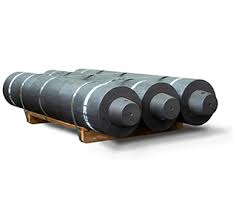What is the process of manufacturing graphite electrodes?
The manufacturing process of graphite electrodes involves several key steps, from raw material preparation to the final product. Here is an overview of the typical manufacturing process:

-
Raw Material Selection: The process begins with the careful selection of high-quality raw materials. Petroleum coke, a byproduct of the oil refining process, is the primary raw material for graphite electrodes. Other materials may include coal tar pitch and a small amount of additives.
-
-
Calcination: The raw materials, primarily the petroleum coke, undergo a process called calcination. Calcination involves heating the materials to high temperatures (above 1200°C or 2192°F) in the absence of oxygen. This step removes volatile components, such as moisture and impurities, and transforms the raw materials into a carbon-rich precursor.
-
-
Mixing and Forming: The calcined material is then mixed with coal tar pitch and, in some cases, additional additives. This mixture is blended to achieve a homogeneous composition. The resulting paste is then formed into the desired electrode shape through extrusion or compression molding.
-
-
Baking: The formed electrodes undergo a baking process in a specialized oven or furnace. During baking, the green electrodes are heated to temperatures ranging from 800°C to 1200°C (1472°F to 2192°F). This step further removes volatile substances, solidifies the structure, and transforms the material into a porous carbon structure.
-
-
Impregnation (Optional): Some graphite electrodes may undergo an impregnation process. This involves immersing the electrodes in a liquid pitch or resin, followed by additional baking. Impregnation enhances the density and strength of the electrodes.
-
-
Graphitization: The baked electrodes then undergo graphitization, a high-temperature process that typically exceeds 2500°C (4532°F). During graphitization, the carbon structure is rearranged to form graphite, resulting in improved electrical conductivity and other desirable properties.
-
-
Machining: The graphitized electrodes are machined to achieve the final dimensions and specifications required for various industrial applications. Precision machining ensures the electrodes meet the specific requirements of electric arc furnaces.
-
-
Quality Control: Throughout the manufacturing process, rigorous quality control measures are implemented. This includes testing the raw materials, monitoring the various stages of production, and conducting inspections on the finished graphite electrodes to ensure they meet industry standards.
-
-
Finishing and Coating (Optional): Depending on the application, electrodes may undergo finishing processes, such as surface coating or treatment, to enhance their performance or extend their lifespan.
-
-
Packaging and Shipping: The finished graphite electrodes are carefully packaged to prevent damage during transportation. They are then shipped to steel mills, foundries, and other industries where they will be used in electric arc furnaces for the production of steel and other metals.
The entire manufacturing process is highly specialized and requires expertise to produce high-quality graphite electrodes that meet the stringent requirements of industrial applications.





